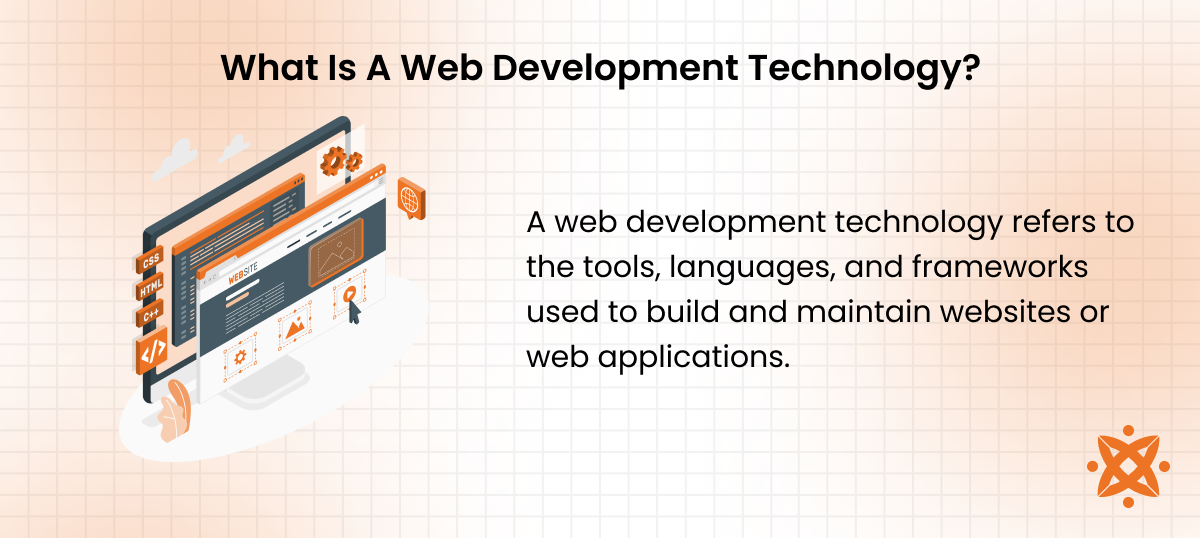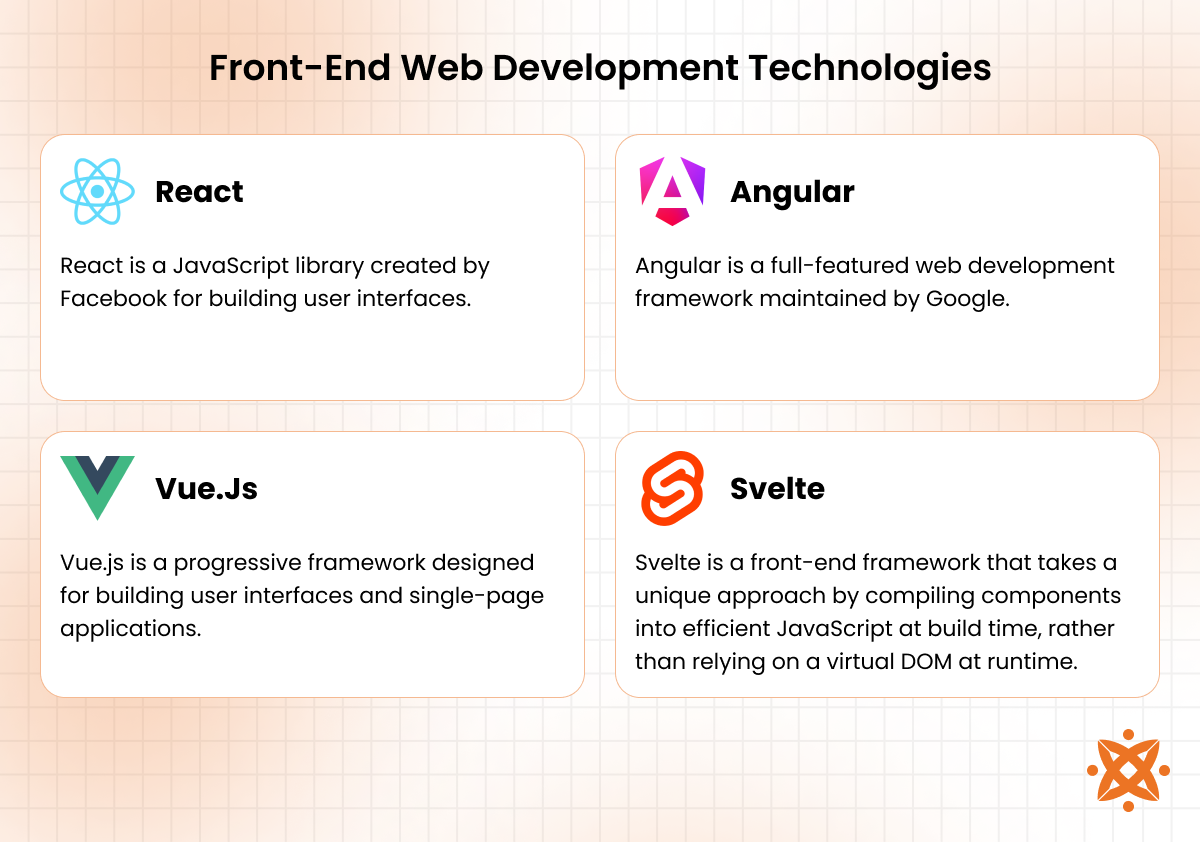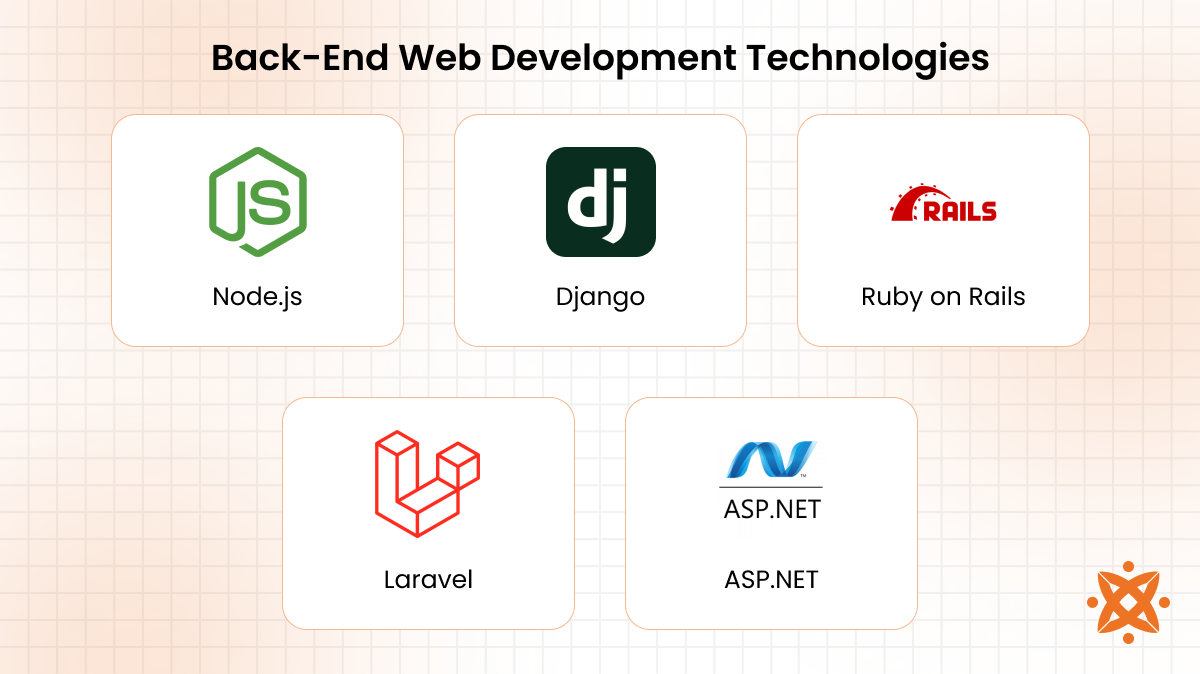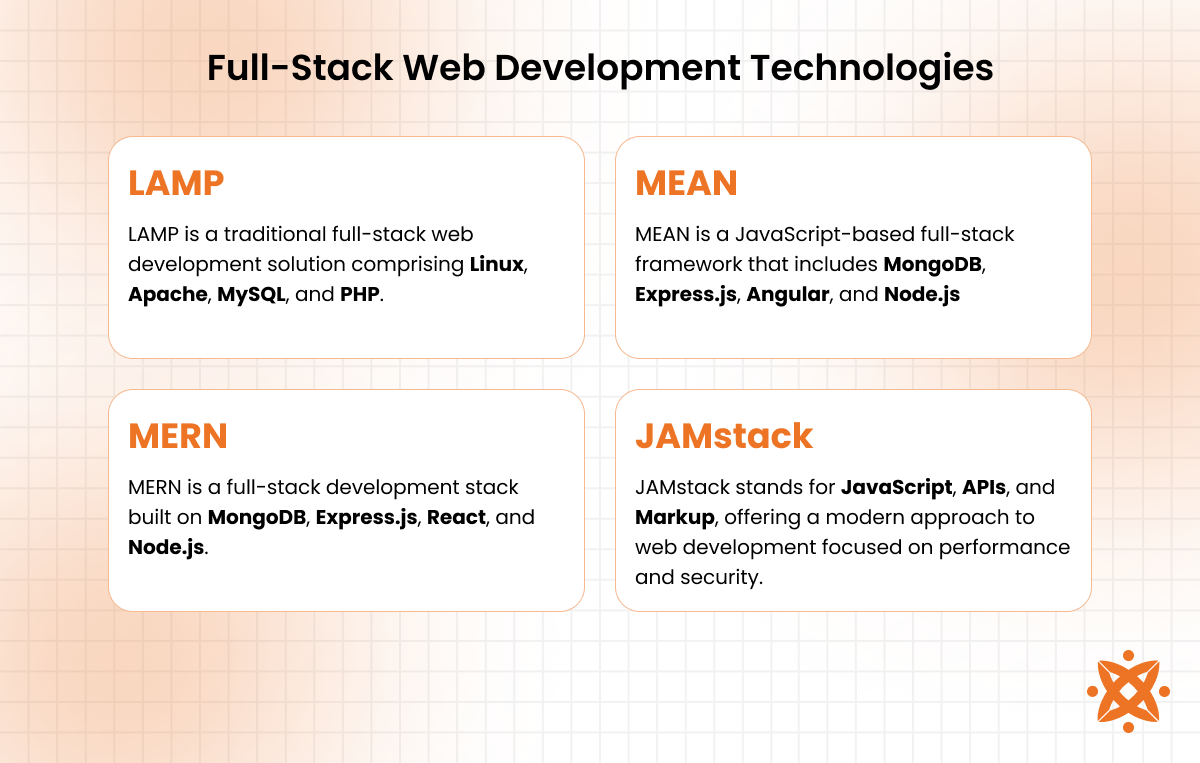
Web development technologies are the foundation of how websites and web applications are built, function, and evolve. In practical terms, they include the tools and systems that developers use to structure content, manage data, and enable interactions between users and servers.
Some of the most widely used web development technologies include React, Angular, Vue.js, Node.js, Django, Ruby on Rails, Laravel, ASP.NET, LAMP, MEAN, MERN, JAMstack, MySQL and PostgreSQL, MongoDB, and Firebase for front-end interfaces, back-end logic, full-stack development and databases. These technologies enable flexible, scalable development across various programming language environments.
To choose the right tech stack for a website, start by defining the project type, expected traffic, and technical requirements. Consider whether you need a dynamic application with real-time features or a static content-focused platform.
According to JetBrains (2024), React is regularly used by approximately 64% of developers, Vue by 32%, Angular (2+) by 24%, and Svelte by 7%.
What Is A Web Development Technology?
A web development technology refers to the tools, languages, and frameworks used to build and maintain websites or web applications. These include both client-side (front-end) and server-side (back-end) components, enabling you to create dynamic, responsive, and interactive digital experiences. Technologies range from HTML, CSS, and JavaScript to more complex systems like Node.js, Django, and React.

Understanding and selecting the right web development technology is important because it directly affects your website's performance, scalability, and maintainability. It also determines how well your platform integrates with modern trends such as mobile responsiveness, REST APIs, real-time data updates, and SEO performance.
Efficient technology choices improve developer productivity, reduce development time, and enable performance optimisation for a better user experience.
Front-End Web Development Technologies
The most popular front-end web development technologies include React, Angular, Vue.js, and Svelte. These tools are widely used to build the user-facing side of websites and applications, ensuring interactive, dynamic, and responsive user experiences.

The most popular front-end web development technologies are as follows:
React
React is a JavaScript library created by Facebook for building user interfaces. It allows you to design components that manage their own state and are combined to form complex UIs. React is especially known for its virtual DOM system, which updates only parts of the page that change, leading to faster rendering.
Key features of React include a component-based structure, reusable code, and support for hooks to manage logic within functional components. Its advantages include improved performance through virtual DOM, strong community support, and seamless integration with other tools.
On the downside, React has a steep learning curve for beginners and frequent updates that complicate long-term maintenance.
Angular
Angular is a full-featured web development framework maintained by Google. It enables you to build complex single-page applications through a structured and scalable architecture. With its declarative templates and dependency injection, Angular promotes maintainable and testable codebases.
Angular features include two-way data binding, built-in routing, and support for TypeScript, which adds static typing and modern JavaScript features. The main advantages are its powerful CLI, comprehensive documentation, and robust performance for large-scale apps. However, Angular has a steeper learning curve and is heavy for small projects due to its large bundle size.
Vue.js
Vue.js is a progressive framework designed for building user interfaces and single-page applications. It focuses on an approachable core library that integrates smoothly with other tools or libraries, allowing you to scale from simple interfaces to complex applications.
Key features of Vue.js include a reactive data model, component-based structure, and seamless integration with existing projects. Its pros are its gentle learning curve, small size, and strong performance in rendering.
On the downside, Vue has a smaller enterprise adoption compared to React or Angular, and its ecosystem is less standardised, which may affect consistency in large-scale development.
Svelte
Svelte is a front-end framework that takes a unique approach by compiling components into efficient JavaScript at build time, rather than relying on a virtual DOM at runtime. This model reduces browser workload, allowing you to write minimal, clean code that translates into fast-performing applications.
Notable features include built-in reactivity without extra code, zero runtime overhead, and a straightforward syntax. Its benefits are faster load times, less boilerplate, and ease of learning for newcomers. However, Svelte has a smaller community, limited third-party tooling, and reduced support in enterprise environments compared to more established frameworks.
Back-End Web Development Technologies
The most popular back-end web development technologies include Node.js, Django, Ruby on Rails, Laravel, and ASP.NET. These technologies power the server-side of web applications, handling data processing, routing, database interactions, and integration with front-end components.

The most popular back-end web development technologies are explained below:
Node.js
Node.js is a server-side platform built on the V8 JavaScript engine, enabling JavaScript to run outside the browser. It allows you to build fast and scalable network applications using a non-blocking, event-driven architecture that handles many connections simultaneously.
Its features include asynchronous I/O, a large npm ecosystem, and support for building real-time applications like chats and APIs. The advantages include high performance, full-stack JavaScript development, and active community support. Downsides involve challenges with CPU-intensive tasks, callback-heavy code structure, and less mature libraries for complex enterprise features.
Django
Django is a high-level web framework built with Python that promotes rapid development and clean, pragmatic design. It comes with a set of ready-to-use components that help you build secure and maintainable web applications efficiently, following the convention-over-configuration principle.
Key features of Django include an ORM for database management, a built-in admin interface, robust security features, and a clear project structure. Pros include fast development, scalability, and strong documentation. Cons include a monolithic design that is rigid for microservices, a steep learning curve for beginners, and performance limitations for real-time apps.
Ruby on Rails
Ruby on Rails is a web development framework built with the Ruby language, designed to simplify coding by favouring convention over configuration. It enables you to build database-backed applications quickly, using a clear MVC structure that separates concerns across the app.
Its features include scaffolding tools, integrated testing frameworks, and a rich library of community gems. The benefits are rapid development speed, elegant syntax, and strong developer productivity. On the flip side, Rails are slower in performance, less flexible for unconventional architectures, and demanding in terms of memory usage.
Laravel
Laravel is a PHP-based web framework that focuses on elegant syntax and developer-friendly tools. It supports a modular and scalable structure, making it easier for you to build secure and maintainable applications with minimal overhead.
Key features include an expressive routing system, built-in authentication, Blade templating engine, and integrated task scheduling. Its strengths lie in extensive documentation, ease of use for new developers, and robust community packages. However, Laravel lags in performance under high load, depends heavily on third-party tools, and requires deeper PHP knowledge for advanced use.
ASP.NET
ASP.NET is a web development framework developed by Microsoft, designed for building dynamic web applications and services using .NET and C#. It allows you to create robust, scalable applications with deep integration into Windows environments.
Features include support for MVC architecture, built-in security frameworks, and compatibility with cloud services like Azure. Its advantages are strong performance, enterprise-level support, and seamless integration with Microsoft tools. Disadvantages include a steeper learning curve for non-.NET developers, heavier resource usage, and a smaller open-source ecosystem compared to other back-end options.
Full-Stack Web Development Technologies
The most popular full-stack web development technologies include LAMP, MEAN, MERN, and JAMstack. These stacks combine both front-end and back-end technologies, allowing you to develop complete web applications with unified tools and practices.

The most popular full-stack web development technologies are:
LAMP
LAMP is a traditional full-stack web development solution comprising Linux, Apache, MySQL, and PHP. It provides a reliable, open-source environment that allows you to build and deploy dynamic web applications efficiently, with each component handling a specific layer of the stack.
Its features include a flexible architecture, broad hosting support, and compatibility with various CMS platforms. Pros include a large knowledge base, ease of configuration, and low-cost setup. Cons involve limited scalability for modern web demands, manual integration requirements, and outdated performance compared to newer stacks.
MEAN
MEAN is a JavaScript-based full-stack framework that includes MongoDB, Express.js, Angular, and Node.js. It enables you to build end-to-end web applications using a single language across all layers, refining development and reducing context switching.
Its features include JSON data handling across the stack, scalable NoSQL storage, and a modular structure. The advantages are real-time data support, full-stack JavaScript consistency, and active community resources. On the downside, MEAN is complex to debug, Angular's learning curve is slow for onboarding, and MongoDB does not suit all data models.
MERN
MERN is a full-stack development stack built on MongoDB, Express.js, React, and Node.js. It allows you to create powerful single-page and dynamic web applications using JavaScript throughout, giving you full control over both front-end and back-end components.
Core features include virtual DOM for UI efficiency, a flexible NoSQL database, and rapid API development. The stack's benefits include smooth JavaScript development, reusable React components, and scalable architecture. Its limitations include potential SEO challenges, complex state management in React, and less built-in structure compared to Angular in MEAN.
JAMstack
JAMstack stands for JavaScript, APIs, and Markup, offering a modern approach to web development focused on performance and security. It separates the front-end from the back-end, allowing you to serve pre-built static files through a CDN while handling dynamic functions via APIs.
Its features include static site generation, serverless architecture, and decoupled front-end frameworks. The pros are fast load times, simplified hosting, and enhanced security due to reduced server dependencies. Cons include reliance on third-party services, complexity in handling dynamic content, and limited real-time capabilities out of the box.
Web Development Databases
The most popular databases used in web development include MySQL, PostgreSQL, MongoDB, Firebase, and SQLite. These databases manage the storage, retrieval, and organisation of data in web applications, supporting everything from simple blog platforms to large-scale enterprise systems.
The most popular databases used in web development are as follows:
MySQL
MySQL is a widely used relational database management system based on Structured Query Language. It enables you to store and organise data in tables with predefined schemas, making it suitable for applications that require consistency and reliability.
Features include ACID compliance, support for complex joins, and compatibility with various programming languages. Its advantages are widespread adoption, ease of setup, and strong community support. On the downside, it has limitations with complex analytical queries, less efficient performance for large-scale reads, and limited NoSQL-like flexibility.
PostgreSQL
PostgreSQL is an advanced open-source relational database system known for its emphasis on extensibility and standards compliance. It supports complex data operations, allowing you to manage large datasets and execute sophisticated queries with precision.
Its features include full ACID compliance, support for JSON and XML data types, and powerful indexing and concurrency mechanisms. Advantages include high performance for read-heavy operations, robust data integrity, and support for custom functions. Drawbacks include a steeper learning curve for newcomers and higher resource usage compared to simpler databases.
MongoDB
MongoDB is a document-oriented NoSQL database designed for flexibility and scalability. It allows you to store data in JSON-like documents, making it easier to handle dynamic and hierarchical data structures in modern web applications.
Key features include schema-less design, built-in replication and sharding, and support for real-time analytics. Benefits include rapid development, horizontal scaling, and ease of use with JavaScript-based stacks. Downsides include weaker support for complex transactions, higher memory consumption, and potential issues with data consistency in distributed systems.
Firebase
Firebase is a backend-as-a-service platform developed by Google that provides a suite of cloud-based tools for building and managing web and mobile apps. It lets you focus on the front end while handling server-side operations like database management, authentication, and hosting through its services.
Its features include a real-time NoSQL database, cloud functions, integrated analytics, and user authentication. Advantages include quick setup, real-time updates, and seamless integration with Google Cloud. The drawbacks are limited query capabilities, potential vendor lock-in, and scaling challenges for complex or highly customised apps.
SQLite
SQLite is a lightweight, file-based relational database engine widely used in embedded systems and small-scale web applications. It requires no server setup, letting you manage data directly from a single file, making it ideal for apps with moderate data needs and minimal concurrency.
Notable features include zero configuration, full SQL support, and minimal footprint. The advantages are fast local performance, easy integration, and no need for a separate server process. Its limitations include limited concurrency support, a lack of advanced security features, and challenges in scaling for high-traffic web platforms.
How To Choose The Right Tech Stack For Web Development?
To choose the right tech stack for web development, you need to evaluate several factors, including project type, scalability needs, team expertise, maintenance requirements, and long-term goals. These considerations help ensure that your chosen technologies align with the specific needs and constraints of your web project.
To choose the right tech stack for web development, the factors to evaluate are:
- Project requirements: Consider whether you're building a static website, dynamic application, real-time platform, or e-commerce site. Each has different architectural demands and tool compatibility.
- Scalability: Evaluate how well the stack grows with your user base. Choose tools that support horizontal or vertical scaling without extensive refactoring.
- Team expertise: Use technologies that your developers are already comfortable with or learn quickly, reducing development time and error rates.
- Community and support: Opt for stacks backed by active communities and strong documentation, which help troubleshoot issues and keep you updated with best practices.
- Maintenance and updates: Consider how easily the stack is updated or debugged. Well-maintained tools reduce long-term technical debt and security risks.
- Integration needs: Ensure the stack integrates well with third-party services like payment gateways, CRMs, or analytics platforms, especially for commercial or enterprise applications.
- Budget and licensing: Take into account any licensing fees or hosting costs. Open-source solutions reduce expenses, but require more technical setup.
What Is The Best Front-End Technology For Web Development?
The best front-end technology for web development is React. Its component-based architecture allows you to build interactive user interfaces with reusable code, making development faster and more efficient. React's virtual DOM ensures fast rendering and updates, enhancing the user experience on dynamic and complex web applications.
A large community, extensive third-party libraries, and strong integration capabilities with back-end services and APIs support React. Its flexibility and scalability make it suitable for projects of all sizes, from simple landing pages to enterprise-grade platforms.
What Is The Best Back-End Technology For Web Development?
The best back-end technology for web development is Node.js. It supports non-blocking, event-driven architecture, allowing you to handle multiple requests efficiently and build scalable applications. Node.js is particularly effective for real-time services like chats and streaming due to its asynchronous nature.
With access to a vast npm ecosystem and the ability to use JavaScript across the stack, Node.js reduces development complexity. It integrates well with modern front-end frameworks and supports rapid prototyping, making it a go-to choice for startups and high-performance applications alike.
What Is The Best Full-Stack Technology For Web Development?
The best full-stack technology for web development is the MERN stack. It combines MongoDB, Express.js, React, and Node.js, offering a unified JavaScript environment from front to back. This consistency simplifies the development process, reduces context switching, and allows for faster feature deployment.
MERN is well-suited for dynamic web applications, supporting modular code, real-time data handling, and flexible scaling. Its wide community support and active ecosystem make it a reliable choice for both startups and established businesses aiming to build responsive, modern web platforms.
What Is The Best Database For Web Development?
The best database for web development is PostgreSQL. It offers robust data integrity, full ACID compliance, and support for both structured and semi-structured data, making it versatile for a wide range of web applications. Its advanced features, like full-text search, custom data types, and indexing, provide the power needed for complex queries and high-performance tasks.
PostgreSQL is highly scalable, secure, and well-documented, with broad language support and integration capabilities. These qualities make it ideal for developers seeking a reliable and feature-rich relational database for both small and enterprise-grade web platforms.
What Is The Best Web Development Technology For Startups?
The best web development technology for startups is the MERN stack. Its use of JavaScript across all layers simplifies development and allows small teams to build quickly with a single language. MERN supports modular and scalable architecture, helping you launch fast and iterate without major rewrites.
It also offers strong community support, a rich library ecosystem, and compatibility with modern deployment tools. These advantages help startups minimise costs, accelerate time-to-market, and maintain flexibility as they scale or pivot their product offerings.
What Is The Best Web Development Technology For SaaS Websites?
The best web development technology for SaaS websites is the JAMstack architecture. It separates the front-end from the back-end, using pre-rendered static pages served through a CDN and APIs for dynamic functions. This approach delivers fast load times, strong security, and excellent scalability, key requirements for SaaS platforms.
JAMstack supports continuous deployment, integrates seamlessly with modern DevOps pipelines, and reduces server maintenance overhead. Its compatibility with headless CMS, serverless functions, and third-party services makes it ideal for delivering efficient, modular, and reliable SaaS applications.
What Is The Best Web Development Technology For E-Commerce Websites?
The best web development technology for e-commerce websites is the LAMP stack. It provides a stable, customisable, and cost-effective foundation, widely supported by popular platforms like Magento, WooCommerce, and OpenCart. Its use of PHP and MySQL enables seamless integration with payment systems, inventory management, and customer databases.
LAMP supports scalable server setups and has a vast ecosystem of plugins and tools customised to e-commerce needs. Its reliability, security capabilities, and flexibility make it a strong choice for building fully featured online stores that handle transactions and user data effectively.
What Is The Best Web Development Technology For A Progressive Web App?
The best web development technology for a progressive web app is Angular. Its built-in support for service workers, offline caching, and modular architecture makes it well-suited for delivering native app-like experiences on the web. Angular CLI simplifies PWA configuration, allowing you to add features like push notifications and background sync quickly.
Angular's strong performance optimisation, two-way data binding, and TypeScript support also contribute to robust, scalable applications. These qualities make it ideal for PWAs that demand speed, reliability, and seamless user engagement across various devices.
What Is The Best Web Development Technology For A Blog Website?
The best web development technology for a blog website is JAMstack. It uses static site generators like Hugo or Gatsby, combined with headless CMS platforms, to deliver fast-loading, secure, and easily maintainable content-driven sites. Since blog content is usually read-heavy and updated periodically, JAMstack's pre-rendering and CDN delivery model ensures optimal performance.
It also enables easy integration with content APIs, SEO tools, and deployment platforms like Netlify or Vercel. This approach simplifies publishing workflows and enhances user experience without the overhead of server-side processing.
What Is The Difference Between Progressive Web Apps And Native Apps?
The main difference between progressive web apps and native apps is how they are built and deployed. PWAs are web applications that run in browsers but offer features similar to native apps, such as offline access, push notifications, and installability, without needing to be downloaded from app stores.
Secondary differences include development cost and platform dependence—PWAs are built once and work across devices, while native apps require separate versions for iOS and Android. Native apps offer deeper device integration and better performance for graphics-heavy tasks, while PWAs are easier to update and maintain without requiring user intervention.
What Is The Difference Between React, Angular And Vue?
The main difference between React, Angular, and Vue is their structure and design philosophy. React is a library focused on building UI components, Angular is a full-fledged framework with extensive built-in tools, and Vue sits in between, offering flexibility with a gentle learning curve and structured capabilities.
Secondary differences include language support and syntax. Angular uses TypeScript by default, while React and Vue use JavaScript with optional TypeScript integration. React relies heavily on third-party libraries for routing and state management, Angular includes these features natively, and Vue balances between built-in features and external integrations.
Should I Choose Node.js Or Django For Backend Web Development?
Choose Node.js if your project demands real-time features, event-driven architecture, or full-stack JavaScript development. Tips for choosing between Node.js and Django are project type, team skill set, development speed, performance needs, ecosystem and scalability. These factors help you match your project's technical needs with the strengths of each framework, ensuring smoother development and long-term maintainability.
Tips for choosing between Node.js and Django are explained below:
- Project type: Node.js is ideal for real-time applications like messaging platforms or live streaming services. Its event-driven nature handles multiple simultaneous connections well. Django, on the other hand, excels in content management systems, financial apps, or large-scale platforms that require structure and stability.
- Team skillset: If your development team is experienced in JavaScript, Node.js allow them to build both client and server components efficiently. This unified language use reduces learning curves and simplifies maintenance. For Python-proficient teams, Django offers familiar syntax and robust tooling out of the box.
- Development speed: Django provides an admin panel, built-in user authentication, and a powerful ORM, which speeds up early-stage development. It's well-suited for rapid MVPs and enterprise apps. Node.js is more flexible but requires manually integrating third-party modules for common features.
- Performance needs: Node.js is well-optimised for handling asynchronous tasks and multiple concurrent users, making it a strong choice for apps that rely on speed and real-time interactions. Django operates synchronously, which supports CPU-heavy operations and offers predictability. For projects involving lots of background tasks, Node.js offer better runtime efficiency.
- Ecosystem and scalability: Node.js has a vast npm ecosystem, giving you access to thousands of modules that suit microservices and scalable APIs. Django supports horizontal scaling and works well with cloud-native tools, but tends to follow a more monolithic pattern. Consider your scaling strategy and system architecture before choosing.
What Is Web Development?
Web development refers to the process of creating and maintaining websites and web applications that operate through internet browsers. It involves a combination of programming, design, server management, and database handling to ensure a functional and user-friendly digital presence.
There are three main types of web development: front-end, which focuses on the visual interface and user experience; back-end, which manages data, servers, and application logic; and full-stack, which combines both to deliver complete, end-to-end web solutions. Each type plays a specific role in building modern, interactive web platforms.
Never Miss an Update From Us!
Sign up now and get notified when we publish a new article!
Oliver Baker
Co-Founder
Oliver Baker is a co-founder of Intelivita, a leading Web and Mobile App Development Company based in Leeds, UK. Oliver has been at the forefront of the business, expanding it globally and into new technologies including iOS and Android, AR, VR and Mobile Game applications. Oliver excels in Project Management, Leadership, Quality Assurance and Problem Solving and has qualifications with Prince2 and APM. He aims to develop his skills further through a shared interest with other leaders in the Software Markets and the Clients of Intelivita.
